Creative Testing Best Practice Guide: How To Turn Creative Into Winning Ads
.png)
Repeat after me: The best ads don’t look like ads. The best ones are native, raw, shaky, timely, vertical and don't require sound.
How do we know this? Through the creative testing process.
Using all of the knowledge we’ve built on redistributing influencer content within hundreds of Facebook ad accounts, we’ve put together this crash course on creative testing to help you comprehensively understand our creative testing process—so you can apply it to your brand’s creative testing practices.
We’ll cover:
- What is Creative Testing & Why is it Important?
- How to Approach Creative Testing: 4 Fundamental Steps to Follow
- How to Set Budgets for Creative Testing (Without Losing Money)
- Creative Testing Quiz: The Winner Will Surprise You
- Creative Testing Measurement Using AIDA Metrics
📚 Related: How To Set Up Your Ad Account in a Tactical Way To Launch Mass Amounts of Influencer Creative
What is Creative Testing & Why is it Important?
Picture this: you've got a sea of brands out there all shouting to get noticed, making the ad space feel like Times Square on New Year's Eve. How do you rise above the noise?
Creative testing is a process you use in advertising to identify the most effective creative elements and concepts for your campaigns. This involves creating various versions of an advertisement— with different designs, copy, and call-to-actions, among other elements— and testing them against each other to see which one your target audience responds to the best.
By testing different creative concepts, you're serving up the personalized and authentic experiences that today's audiences love. This helps you better connect with your target audience, building their engagement with your brand.
Also, let's not forget how smart tech is getting. With machine learning and artificial intelligence in digital advertising, we can deep-dive into audience behavior, picking up on subtle patterns and preferences. Creative testing becomes your key to unlocking these insights, shaping ad content to hit home with different audience segments.
Then there's the data. These days, marketing is as much about numbers as creativity. Creative testing gives you the hard facts, guiding your decisions and helping you channel your ad spend where it's going to make the most impact to drive sales. No more guesswork, no more wasted dollars—just data-driven decisions that get results.
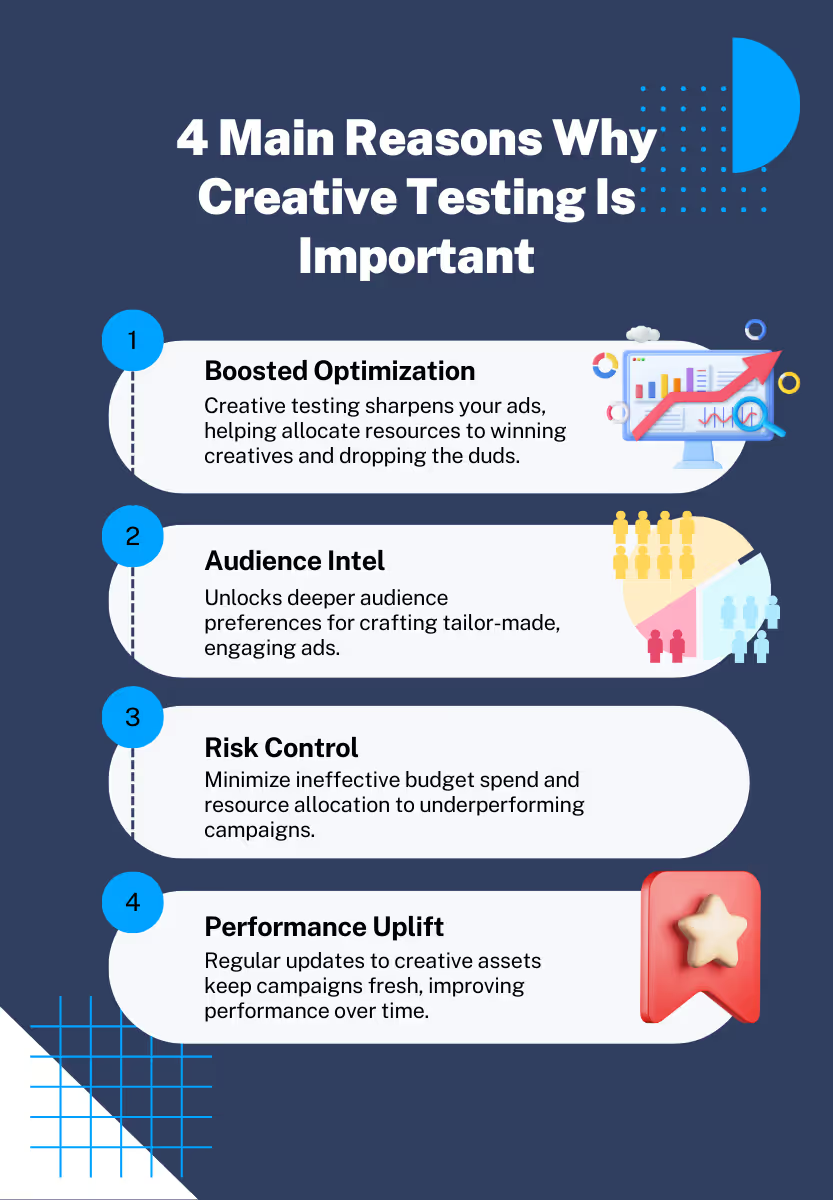
How to Approach Creative Testing: 4 Fundamental Steps to Follow
Winning ads aren't just a result of extensive reading or studying; they are born from creative testing. But how do you get that much creative to test?
Step One: Harness Influencer-Generated Creative Consistently Every Month through Influencer Seeding
The most authentic and compelling ad content you can utilize for creative testing often comes from influencers. Their posts have the potential to deliver a powerful message about your product to an engaged audience.
What is Influencer Seeding?
Influencer or product seeding is a strategy that involves giving influencers your products for free. This encourages them to use, review, or promote these products to their audiences, enhancing brand visibility and reach across platforms like Facebook, Instagram, YouTube, and TikTok.
📚 Related: Read our full guide to product seeding
This strategy is exactly how we manage to beat creative fatigue and get hundreds of new creatives per month for our clients. To capture each piece of content, we use a tool called MightyScout.
MightyScout keeps track of all of the influencers we seed products to and records all of the content the creators post about our clients.
After a few weeks, we’ll have a library of 60-90 pieces of content inside MightyScout from various influencers, and all it cost was the Cost of Goods Sold (COGS). Once we’ve captured this content from the influencers, we reach out to them for usage rights before we start a creative test.
This keeps our relationship with the influencers as solid as possible and protects us from legal issues with using other people’s content.
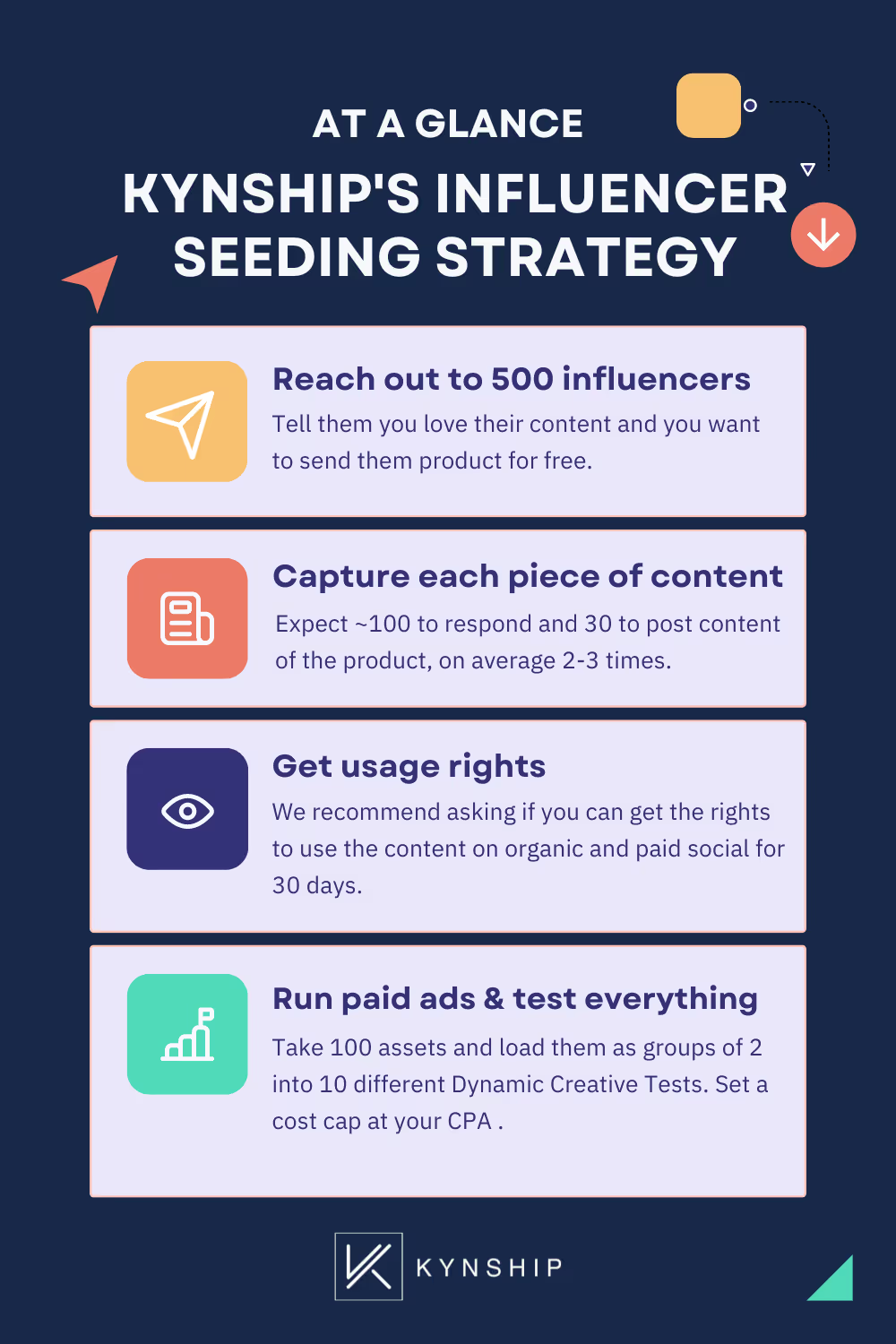
Case Study: Boosting Beekman 1802's Creative Ad Portfolio
Step 1: Product Evaluation for Influencer Seeding
We first examined Beekman 1802's product, assessing if influencers would endorse it. Thanks to its clean, health-promoting ingredients and brand ethos – one that is clinically kind, scientifically proven, and suitable for sensitive skin—the answer was a definite "yes." Its alignment with buzzwords like "all-natural", "organic", and "sustainable" further increased its suitability for influencer seeding.
Step 2: Evaluating the Product's 'Film-ability'
Our next focus was the product's ability to integrate seamlessly into creator content. Beekman 1802 passed this test with flying colors, easily fitting into common video formats like:
- Morning/evening routine
- Product tutorial video
- GRWM (get ready with me)
Influencers frequently discuss their skincare products, so Beekman's products fit naturally into their narratives.

Results
Our influencer seeding approach led to an abundance of ad creatives to test and impressive exposure for Beekman 1802:
- 475 posts with usage rights, allowing the brand to repurpose the content into 647 assets for use in paid media
- 2.346M impressions, resulting in a $1.83 CPM.
This example highlights the potential success of influencer seeding when the right product is paired with a well-planned strategy. But to get the outcome (results), you must launch every piece of creative at your disposal.
Step Two: Launch Every Single Piece of Creative With Cost Caps
This is where the fun part starts. As an advertiser, you get to dive into the ad creative process, manipulating various ad elements as you design and test ad creatives.
Here are some things you can do with all of the influencer content you have available:
- Make a montage of social proof from multiple influencers
- Attach new hooks to each video from another influencer
- Test one 30s video vs two 15s videos of the same asset
- Try different background music for each video
You’ll realize that each video out of 90 could turn into over 200 with all the variations you can make.
At Kynship, our favorite content tool that can digest raw images and videos and generate well put together ad creative is Pencil.
📚 Related: Read more about Leveraging AI Tools in Generating Ad Copy Creative Variations at scale.
Lastly, Why Cost Caps?
In five words: generate revenue, protect the downside.
Step Three: Implementing & Optimizing Creative Concepts In Facebook Ads Dashboard
In this stage, you'll put the creative to work inside your Facebook ads dashboard. It's about consistently identifying top-performing ad creatives within Dynamic Creative Tests (DCTs) and launching them into new campaigns. Then, supplement ad campaigns that aren’t optimizing with new creative constantly.
Given the unique scenario where we often have more creative assets than typical advertisers do when running an ad account, we've crafted a unique approach to leverage this abundance. This method is particularly beneficial when dealing with a large volume of creatives.
As far as possible, we align our strategy with Facebook's recommended best practices, referred to as Power5. We utilize Campaign Budget Optimization (CBO) campaigns, which Facebook prefers over Ad Set Budget Optimization (ABO), to distribute the budget most profitably across each ad set.
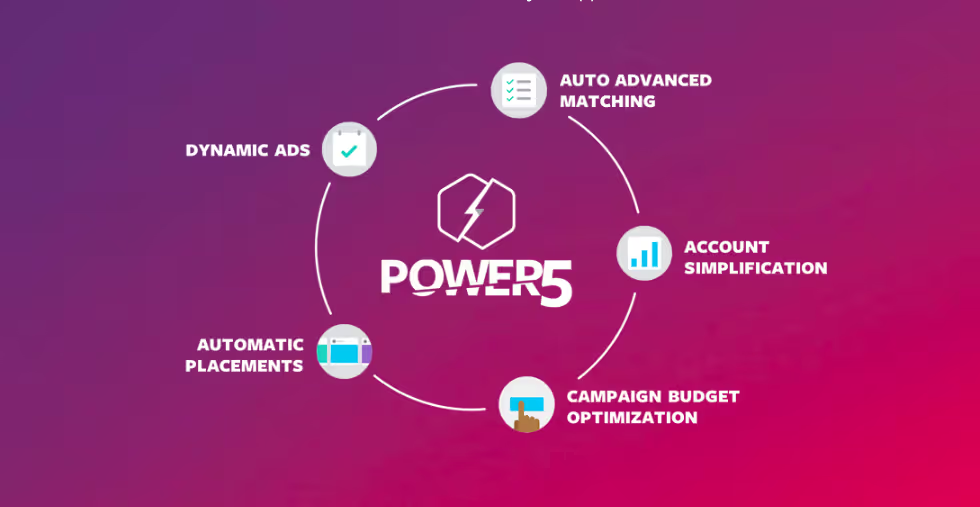
The Creative Testing Gameplan
If we were to create one campaign with 10 ad sets, each ad set would compete for the budget, making it difficult to exit the learning phase. If one ad set performed exceptionally well— at a $25 CPA— it would attract most of the budget, leaving us with limited insight into the performance of creatives in other ad sets.
To avoid this, our creative strategy now involves using one campaign set to CBO, one ad set with a cost cap, and one ad featuring two creatives in a DCT. This alignment with Facebook's best practices enables us to identify which creative concept drives campaign spending precisely. It also ensures that our ad sets are not competing against each other for budget allocation.
The ultimate goal is to have as many campaigns spending efficiently as possible. Instead of having a single campaign spending $25,000 a day, we aim to create 10 campaigns spending $2,500 each per day or even 100 campaigns spending $250 each per day. This distributed approach promotes efficiency and maximizes the potential of our own creative team and assets.
Here’s how to put your creative concepts to work:
- Take your creative assets, and load them as groups of 2 into ten different DCTs (Dynamic Creative Tests—as long as you set a cost cap at your CPA, you won’t lose money
- You may see only 3 out of 10 DCTs performing
- Take those three ad sets and create three new “best performing” DCTs
- Put in new creatives to replace from the bottom
📚 Need the full guide on this? Check out How To Set Up Your Ad Account in a Tactical Way To Launch Mass Amounts of Influencer Creative
Step Four: Scale Your Creative Testing By Leaning Into Facebook’s Machine Learning Algorithm
Don’t underestimate the advertising effectiveness of Facebook’s AI. Facebook will figure out which videos are good and which videos aren’t.
Think one of your videos sucks? Let Facebook be the judge. Think a video is going to crush it? Let Facebook be the judge.
It’s hard to swallow, but setting aside your pride for running paid advertising on Facebook or Instagram is more successful than you think.
Case in point: the video below had a 16X ROAS on one of our ad accounts.
Unfortunately, the client wanted the ad taken down for a few reasons. It didn’t represent the brand well enough, it wasn’t clear the creator was using their product, and the brand wasn’t referenced in the video. Tricky. The least-desirable ad for this account was a top performer.
But the lesson is valid. It’s best to lean into Facebook’s machine learning system to make creative decisions for you. We would never have learned this if we didn’t run this ad through our cost-cap bid strategy.
The way we run ads, we only spend money if we make money. We create Dynamic Creative Testing campaigns with cost caps set below our CPA target. It only allocates spend to the ads that are well received. It makes it impossible to lose.
Even though we decided to take down the other ad tests for this account, it showed us always to run test ads for every piece of content, even if you don’t think it will perform.
Because you might end up making $16 for every $1 you spend on the platform that everyone thinks is dead.
How to Set Budgets for Creative Testing (Without Losing Money)
We use a profit analysis to set Cost Caps and CPA targets, which in turn sets budget. Here is what it may look like:
- 50 purchases per week per ad set - recommended budget to optimize
- $10 CPA x 50 purchases weekly = $500 Weekly Budget / Ad Set
- $500 x 4 weeks = $2,000 Monthly Budget/Ad Set
- Number of campaigns launched based on the amount of creative
- If we have 100 pieces of creative, we would launch 10 DCTs
- $500 Weekly Budget x 10 campaigns = $5000
- $5000 x 4 weeks = $20,000 Total Monthly
Creative Testing Quiz: The Winner Will Surprise You
Let’s play a quick guessing game, brought to you by Kynship’s Paid Media Specialist Nicholas Bauer. Take a close look at each of the three videos below.
One of the creatives below has decreased CAC by 52% on Facebook and Tik Tok. The others have yet to receive a single purchase. Can you tell the difference? Let's find out...
Almost 80% of respondents chose option number two. And they were wrong.
The winner was Option 3. A high-quality close-up photo of the packaging, branding, and details of the product.
Creative Testing Measurement Using AIDA Metrics
An integral part in putting spend behind Creative is understanding AIDA—Attention, Interest, Desire, and Action— Metrics. They are the most reliable metrics we can lean into, as they are the most correlated to Return on Ad Spend (ROAS).
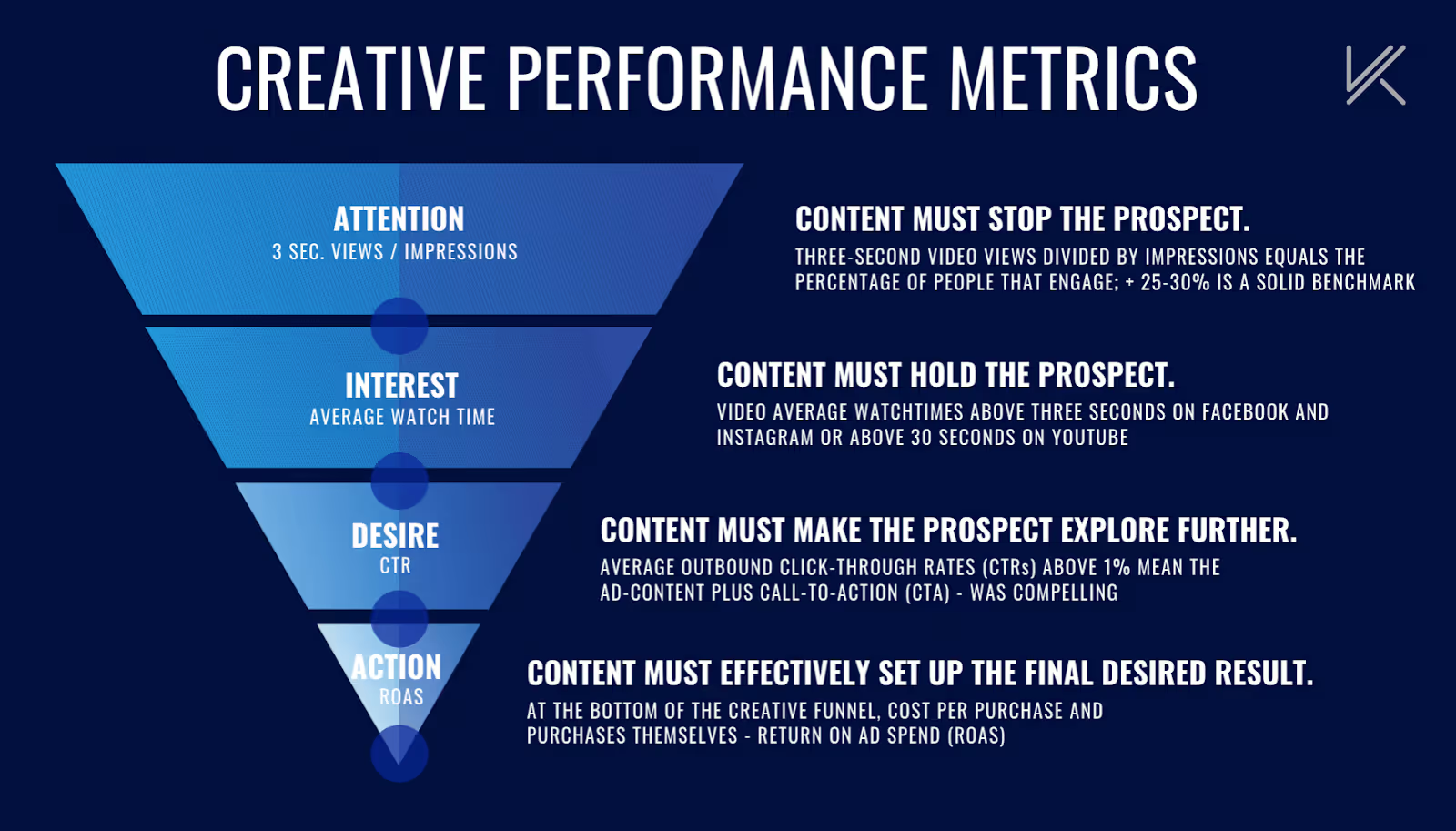
Your Step-by-Step AIDA Metrics Crash Course
Step 1: Assess Attention with Impressions
Your first objective is to evaluate the ability of your creative content to capture the viewer's attention, which is often measured using impressions.
- An impression is a count of the number of times your content is displayed, regardless of whether it was clicked.
- Calculate the ratio of '3 Second Video Viewers' to 'Impressions' to quantify the attention your content is receiving.
- The ratio should ideally be 25-30% or more, indicating your content is engaging enough to halt the viewer's scroll.
Step 2: Gauge Interest with Average Watch Time
Next, assess how well your creative content is able to maintain the viewer's interest.
- This can be quantified using the metric 'Average Watch Time'.
- Aim for an average watch time of more than 3 seconds on platforms like Facebook or Instagram.
- A higher average watch time of more than 30 seconds on Youtube is desirable.
Step 3: Determine Desire with Click-Through Rate
Now, evaluate the extent to which your creative content prompts viewers to explore more about your offering.
- This can be gauged using 'Click-Through Rates' (CTRs).
- The 'Average Outbound CTR' refers to the percentage of viewers who clicked on your content to navigate away from their current activity and explore your offering further.
- A CTR above 1% is generally considered good, suggesting that your ad content and call-to-action (CTA) are compelling enough to incite curiosity in viewers.
Step 4: Measure Action with Return on Ad Spend (ROAS)
Finally, examine the ability of your creative content to encourage viewers to take the desired action, typically making a purchase.
- This is often measured using 'Return on Ad Spend' (ROAS), a metric that compares the revenue generated by your ad campaign to its cost.
- You can also consider the 'Cost per Purchase' and the total amount of purchases to evaluate the effectiveness of your creative content in driving sales.
Remember, these steps provide a general guideline. Different businesses might require different benchmarks based on their unique goals, audiences, and contexts.
Final Thoughts: Success = Testing As Many Creatives As Possible
Creative was important in 2018, but now, it’s imperative. To succeed with Facebook or Instagram Ads, you need to test as many creatives as possible.
After the iOS 14 update, Facebook attribution tanked by 30-50%—even though the overall effectiveness of the app improved. The update caused an attribution issue, not an efficiency issue. That’s why we launch every single piece of influencer content and trust Facebook’s machine learning to tell us what’s working and what’s not.
To measure the success of creative, we use AIDA metrics to analyze the data—this is the best way to see creative performance and find out what creative is more likely to convert.
Here at Kynship, we aren’t an advertising agency, but our combo of great influencer content, Dynamic Creative Tests (DCTs) and cost caps has made some of our clients more money than their main Ad agency. If more brands did this, they’d think that Facebook was in its prime again.
We’ve executed this exact strategy for some of your favorite brands. DTC Darlings, if you will. We’d love to do this for you, too. Let’s chat!
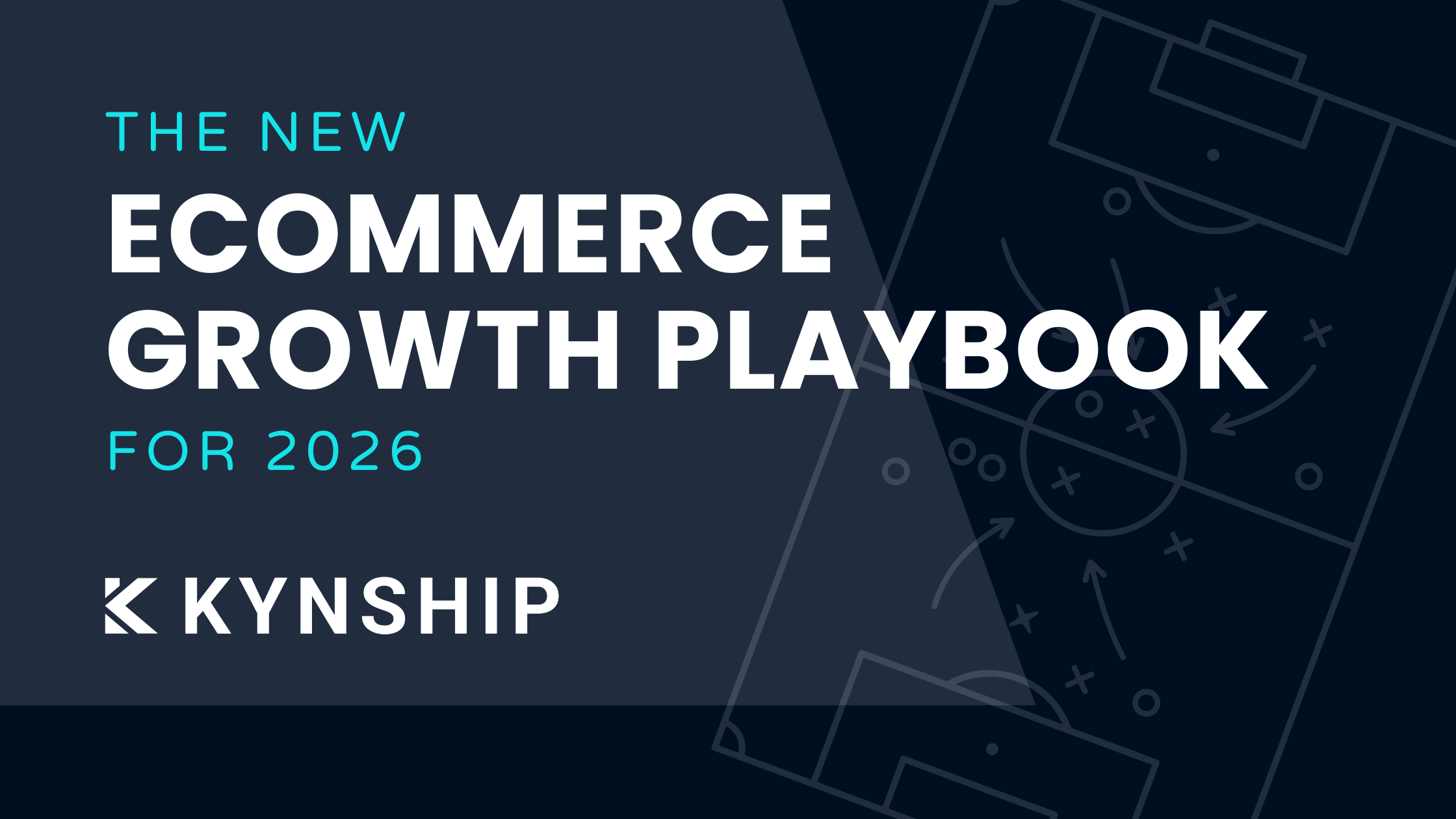
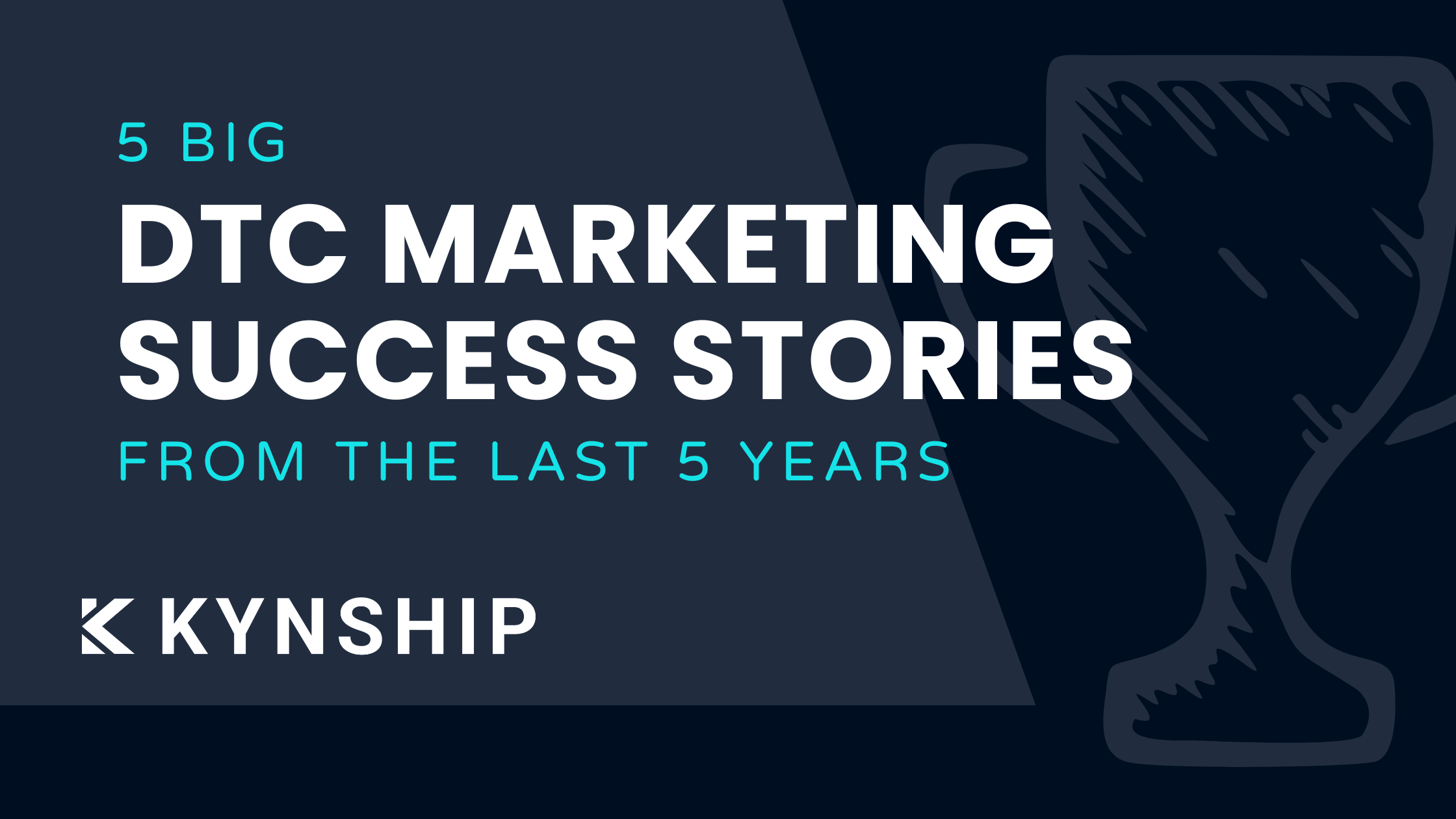
5 DTC Marketing Success Stories From The Last 5 Years
Five real DTC marketing success stories from the last five years, breaking down how brands scaled despite rising CAC, creative fatigue, and tougher competition, plus key lessons you can apply today.

The New Ecommerce Growth Playbook For 2026
These are the ecommerce growth marketing strategies we are using right now to successfully scale DTC brands from $2M to $50M.
Bi-weekly tips to reduce your CAC
Join thousands of DTC operators and subscribe to Cut the CAC for insights from the Bottom Line Podcast and Kynship's growth strategies.


.avif)
.avif)
.avif)



